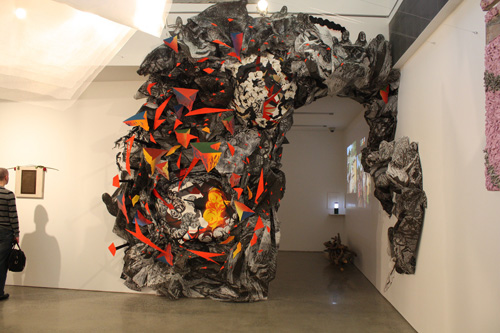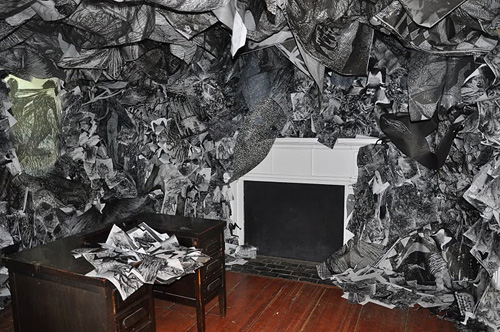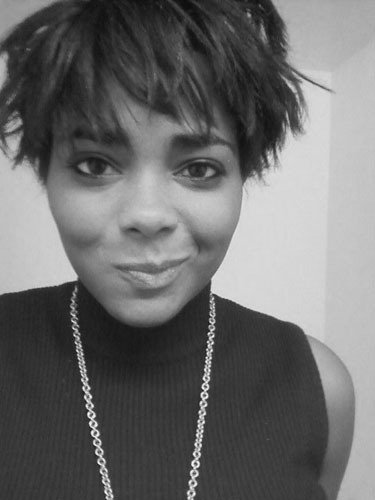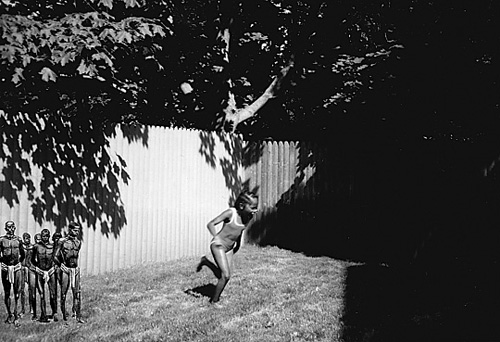Curator Krista Saunders introduced me to artist Sam Vernon during the opening reception of “Made You Look: Hidden Narratives.” Riffing on the traditional ghost story, Sam’s C-print montages combine suburban ennui and appalling antebellum imagery. After graduating from The Cooper Union in 2009, Sam has already received critical attention from several institutions. She was a 2010-2011 A.I.R. Emerging Artist Fellow and recipient of the A.I.R. Emma Bee Bernstein Fellowship. In 2011, A.I.R. Gallery organized her first solo exhibition, “Think On It—Then Lay It Down for Good.” Currently, eight of her photographs and drawings are on view in a group exhibition curated by Creighton Michael called “PENCIL PUSHED: exploring process and boundaries in drawing” in the Ewing Gallery of Art and Architecture, at The University of Tennessee, Knoxville. Sam, at 25, is the youngest person I have interviewed for this column. In October, Vernon is creating a site-specific installation in a group exhibition called “In the Realm of Folklore” in The Emery Community Art Center, at The University of Maine, Farmington. As an older artist, two years shy of 40, I am interested in how money and earned income informs Sam’s aesthetic decisions inside and outside the studio.
BC: What type of work do you create, and why? As you make the work, do you consider the cost involved in the project? How do you strike a balance between the cost of stuff and the work in the studio?
SV: After reading cultural critic Mark Dery’s essay “Black to the Future,” the type of work I create is a strain of Afrofuturism in that I re-imagine the history of the African Diaspora through the lens of science fiction, complex characters and spiritual realms. I’m invested in re-documenting the life and interpretation of African Americans through my own black and white vernacular that’s at once deeply personal and extremely invented. From juxtaposing historical images with family photos, to creating dark, alternative imaginative spaces and figures through my installations and Xerox drawings, my mark-making, patterns and aesthetic is in many ways otherworldly, an alternative universe. I write in my artist statement that the installations are “fear, anxiety and memory translated on flapping sheets. Ghosts congeal and bodies form in dark corners and hang about whispering until the inflection of their voices can be heard among the living.”
I have to consider cost as I make my work for several reasons: experimentation, production, installation, and transportation. In fact, I started making Xerox drawings when I was still a student at The Cooper Union and working an office job 20-25 hours a week. I was taking lithography and silkscreen classes but I knew I needed a cheaper option to make my “prints” because it was hard for me to even pay the discounted print shop rates. Fortunately, the Xerox drawings work conceptually and formally for me—the Xerox machine is a tool. I never want to compromise my artistic vision because of expenses, but during most of my experience as an exhibiting artist I’ve had to find ways to make what I want within a realistic budgetary framework and scale down grandiose ideas. I ask friends for advice, barter skills, etc. My peers, past instructors and mentors have been a great help.
BC: How do you manage your money, and how do you earn income? I want to know how economics, and money-management, affect your decisions inside and outside the studio.
SV: Honestly, I’ve never been obsessive with managing my money, but at 25 I’m learning to be smarter about budgeting and keeping closer account of expenses related to my studio practice, especially for tax purposes. I currently serve as Program Administrator of the Art in Public Places program in Prince George’s County, MD—it’s a contracted position, which gives me more flexibility and pays better than the 9-5 jobs I’ve had in the past. When I lived in New York, my salary was pretty low and it was incredibly difficult to afford a studio, make the work I wanted to, and maintain an average quality of life in the city. There were definitely times I had to choose between buying food and paying my rent on time. Lots of overdrafts! I think those experiences stay with me and I never take for granted what I have now.
I would say economics and money-management is always a concern. I try to track my income and expenses regularly; thankfully I don’t have much debt (student loans, etc.), my bills are reasonable, and I don’t spend too much money on stuff I don’t need. I don’t have a credit card. I can buy the supplies and materials I want to make my work without worrying if I’m going to sell a piece. I can be experimental and take risks.
BC: If you seek monetary compensation as an artist, do you see it as a possible compromise to the type of work you create, and your integrity as an artist?
SV: I don’t think about compensation until after the work is made and I’m asked for a price list. Maybe that will change if and when I start selling my work on a more regular basis. Up until this point I’ve worked with amazing curators and galleries that embrace my work for what it is. My installations take a considerable amount of time to transport, create, and take down so I find with some exhibitions, my 2D work (drawings, photo montages, etc.) is a better option. I’ve never had someone else build my installations for me, and I don’t see this as a compromise. It’s just that creating the site-specific pieces myself is a part of my process and it’s very important to me that I do it. I’ve sold pieces of my installations, but I’ve never sold an entire one.
BC: Do you work to support your art, or does your art support you?
SV: I definitely don’t make enough money from my art to support myself, but then again, I’ve never pursued my artwork full-time, I’ve always had a job or several jobs at once while also having a studio practice.
BC: As an artist, how do you monetize your time, and how do you assign a monetary value to your studio practice?
SV: I have this mantra: “Buy out the time for your work, Sam.” I grew up in a very religious household, studying the Bible was a part of my daily life. I attended religious meetings five times a week until I was 18 years old and dedicated countless hours to reading, researching scriptures, biblical history and principles and ministering. My faith was a part of my everyday life. Though I no longer belong to organized religion, I apply the same diligence to my practice. I carry it with me. It is a way of life, not something separate or apart from who I am or what I do. Sometimes it is difficult to balance my passion for my job with my love for making artwork, but I think it’s a tightrope I’ll be walking on for a lifetime.

Sam Vernon and Rush Baker. “we have never been modern” (installation shot), 2010. Pen and ink, acrylic on canvas, dimensions vary. The Cooper Union, New York, NY.
BC: What percentage of your income is derived from outside sources associated with your art? Teaching, lecturing, visiting artist?
SV: My job as Program Administrator of Art in Public Places means that I’m constantly meeting new people: artists and arts administrators, elected officials, firefighters, police officers, librarians and citizens. I’m civically engaged in the communities I work in and my experience as an artist is why I was hired for the position. I would say my income is directly associated to my art. I have the opportunity to share my work with my colleagues and members of the artistic communities in which I work on a daily basis.
BC: The recent economic collapse laid waste to philanthropic giving, government subsidies, and slashed market prices for most artists. As an artist, there are no guarantees. How did you manage the current fiscal crisis, and how did it affect your work inside and outside the studio?
SV: I graduated from The Cooper Union in 2009 in the midst of the recession. It took me nine months after I graduated to secure full-time employment with a multi-disciplinary arts organization, and even then, it was a seasonal 7-month position. May 2009 to February 2010 was very tough period of my life. Fortunately, I was exhibiting work I made in college, but I didn’t have the money, energy, or motivation to make much new work because I was constantly looking for a job while working several small jobs that still didn’t add up to my cost of living. I thought I would have to move back home and live with my parents. But my partner at the time supported me as much as she could financially and I pulled through. I’ve also had an incredible amount of support from family and friends who didn’t want to see me fail or give up. Years later I am so grateful, and I currently have a job that makes my work inside and outside of the studio easier. I truly believe some of my best work emerged out of frustration, depression, and sadness related to financial difficulty among other personal issues, but the fact that I got through it made me a better artist and a stronger person.

Sam Vernon. “how ghosts sleep (haunted house),” 2009. Pen and ink, xeroxed drawings, dimensions vary. At Smithy‐Pioneer Gallery, Cooperstown, NY.
BC: Have you purchased the artwork of another artist? How did your financial investment in another artist’s artwork influence or inform your practice?
SV: In the past nine months, I’ve had the opportunity to buy paintings and drawings from three artists—Rush Baker, my best friend, and Jenne Glover and Linda Lee Uphoff, two senior artists in the DC area. Prior to these purchases, I could only afford to trade and barter artwork. I bought the pieces first and foremost because I wanted them to belong to me. I had a strong desire to see them every day, examine them and find pleasure in looking again and again. After I bought each piece I felt extreme personal satisfaction—not only because I was supporting talented, intellectual artists I personally believe are worthy of investment, but because I owned extraordinary work. I realized that my own artwork may have created a similar feeling in those who purchased it: a combination of excitement, recognition of ego, and possessiveness. I see the value of my own work and practice differently because I’ve experienced the emotions one may feel buying art. It’s awesome.
BC: You have exhibited your work in numerous nonprofit institutions over the years. According to the 2010 W.A.G.E. Survey (Working Artists for the Greater Economy), nearly 60% of artists that exhibited their work in cultural institutions did not receive any form of payment, compensation or reimbursement. It’s as if the art world expects artists to work for free. What other profession expects this of its workers, to give services away for free? Despite lack of remuneration, many artists agreed to the offer. Why?
SV: For me, exhibiting in nonprofit or alternative galleries has been about the exposure and opportunity to work with amazing gallerists, curators and other artists. I’ve had the chance to experiment, learn from my mistakes, and make it better the next time without pressure to sell. I think of it like a professional apprenticeship. Apprenticeship helps teach the skill of problem-solving. The advancement from apprentice to master takes a long time…That’s where I am right now in my career.









Pingback: An Emerging Artist by the Financial Numbers « HE SAID SHE SAID